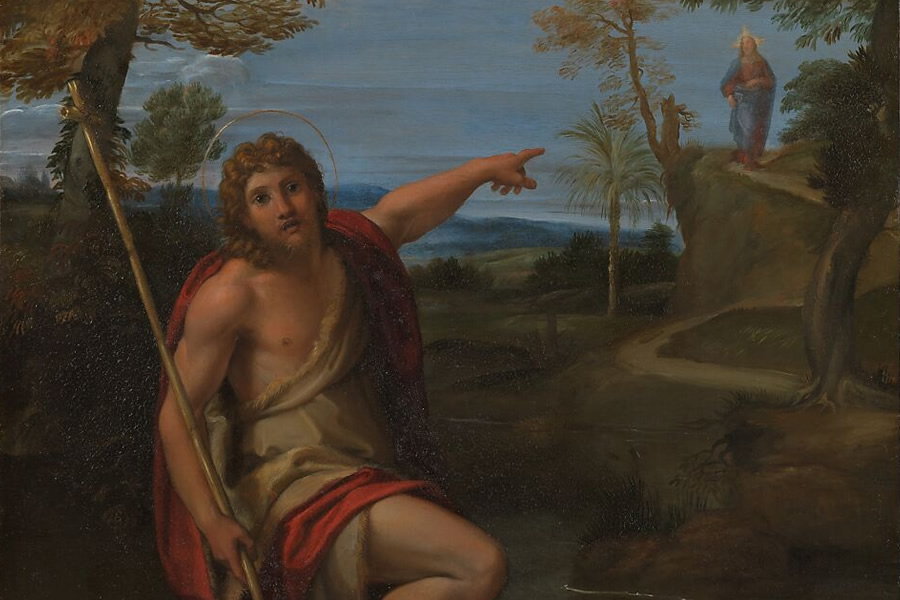
“Saint John the Baptist Bearing Witness”
by Fr. Larry Fraher | 12/14/2023 | Images of FaithToday’s gospel for the Third Sunday of Advent, Cycle C, again proclaims the role of John the Baptist as an essential player on the stage of Salvation History. This week’s pairing of Old and New Testament readings also makes it clear that the action upon the stage of human history is directed by the Holy Spirit. Annibale Carracci’s early17th century work, “Saint John the Baptist Bearing Witness” (oil on copper, c. 1600, New York: The Metropolitan Museum), may offer some assistance as we continue our Advent preparation.
The central figure in the painting is John, positioned just left of center, dressed in camel hair and a scarlet cloak. He bears the traditional staff of the Baptist, thin, with a cross atop, this pictured as made of material found growing near streams. John is depicted near the River Jordan, and for effect, Carracci appears to have made it look as though the water is bottle-necked and flowing through a small channel, while the implement of his baptizing rests in the rocks close by. This is more of a reference to the manner in which Baptisms were handled at the time of the painting (water being poured on the head), rather than a worry about portraying an image as “historically accurate” (full-immersion Baptism). It is also important to notice that John’s eyes are looking straight at the viewer, as an invitation to hear his message. His extended left arm points to Christ, seen as He rounds the bend in the path that descends down toward the river. One notices the halos: John’s is a light circle, while Christ’s is shaped as a cross with the upright and cross beam visible behind His head.
In the Gospel, John defines his purpose: he is “the one who cries out in the desert, ‘make straight the way of the Lord.’” (John 1:23) Notice the path that Christ walks is winding as it moves over the terrain, a symbol of the many twists and turns taken in life, and in following Christ. The Baptist’s arm, however, is direct; pointing straight to Jesus. While the disciple’s path may be filled with curves, the proclamation of John announces a straight one. In recognizing Christ on the path, an additional call is discovered. Christ is not oriented toward John. Instead, if a straight line is drawn from the left side (viewer’s right) of Christ and another from the right elbow (viewer’s left), it is noticed that Christ is facing the small waterfall, and, in fact, the width of the image of Jesus is identical to the width of the waterfall.
The visual dynamics offered in the image present a reminder and a challenge. The reminder is that John the Baptist points us to Christ and that our adherence to Him begins with Baptism. The path is not as winding as we might think; instead it is straight. In Baptism we meet Christ, are conformed to His death and resurrection, and given new life. Here, also, is the challenge. As we prepare for Christmas, how might we recall our own Baptisms? Have we filled the path with more curves and turns than we need, or do we heed the Baptist’s call and make straight the path of our Lord into our homes and our lives? In our daily Advent journey, let us be ready to heed this reminder and respond to the challenge to make straight the path of our Lord into our hearts.
